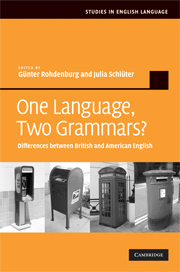Book contents
- Frontmatter
- Contents
- List of figures
- List of tables
- List of contributors
- Introduction
- 1 Colonial lag, colonial innovation or simply language change?
- 2 Compound verbs
- 3 The formation of the preterite and the past participle
- 4 Synthetic and analytic comparatives
- 5 Phonology and grammar
- 6 Prepositions and postpositions
- 7 Argument structure
- 8 Reflexive structures
- 9 Noun phrase modification
- 10 Nominal complements
- 11 Non-finite complements
- 12 The present perfect and the preterite
- 13 The revived subjunctive
- 14 The mandative subjunctive
- 15 The conditional subjunctive
- 16 Tag questions
- 17 The pragmatics of adverbs
- 18 How different are American and British English grammar? And how are they different?
- 19 New departures
- Bibliography
- Index
13 - The revived subjunctive
Published online by Cambridge University Press: 03 July 2009
- Frontmatter
- Contents
- List of figures
- List of tables
- List of contributors
- Introduction
- 1 Colonial lag, colonial innovation or simply language change?
- 2 Compound verbs
- 3 The formation of the preterite and the past participle
- 4 Synthetic and analytic comparatives
- 5 Phonology and grammar
- 6 Prepositions and postpositions
- 7 Argument structure
- 8 Reflexive structures
- 9 Noun phrase modification
- 10 Nominal complements
- 11 Non-finite complements
- 12 The present perfect and the preterite
- 13 The revived subjunctive
- 14 The mandative subjunctive
- 15 The conditional subjunctive
- 16 Tag questions
- 17 The pragmatics of adverbs
- 18 How different are American and British English grammar? And how are they different?
- 19 New departures
- Bibliography
- Index
Summary
Introduction
The reintroduction of subjunctive forms in Modern English is a fascinating story of the reshaping of an important section of the language. Verb forms like be shared in
(1) It was decided that this proposal be shared
were extremely rare up to less than a century ago, not to mention negated forms like not use in
(2) Most dermatologists suggested that you not use these soaps,
but today they are frequently met with in AmE and beginning to appear in BrE. Not surprisingly, the recent restructuring of the verb system has attracted the attention of linguists and resulted in a number of articles and at least one full-length study, Gerd Övergaard's The Mandative Subjunctive in American and British English in the 20th Century (1995). In the following, certain aspects of the process will be discussed. After a general background, dealing with the definition of terms and the history of the subjunctive in English, the discussion will fall into three parts: why the subjunctive returned in AmE, why it returned in BrE and why not occurs before the verb in negated subjunctive constructions.
To illustrate my points I shall be making frequent use of the 57-million-word CobuildDirect Corpus, a corpus containing British (chiefly), American and Australian contemporary material from a variety of mainly written sources. (For a description of the corpus, see Sinclair (1987) and, for example, the Website http://www.titania.cobuild.collins.co.uk)
- Type
- Chapter
- Information
- One Language, Two Grammars?Differences between British and American English, pp. 246 - 256Publisher: Cambridge University PressPrint publication year: 2009
- 5
- Cited by



